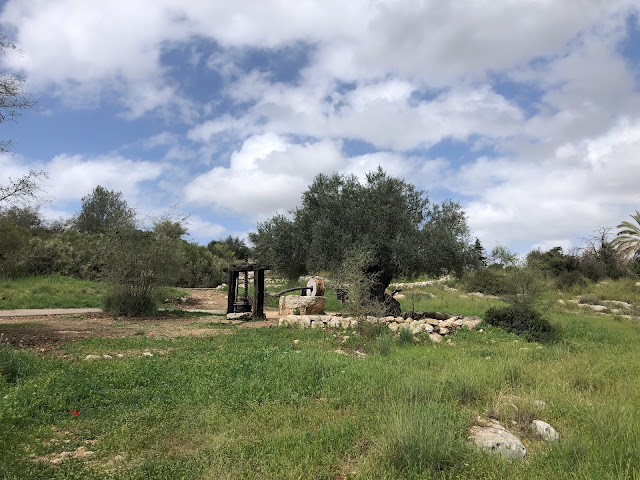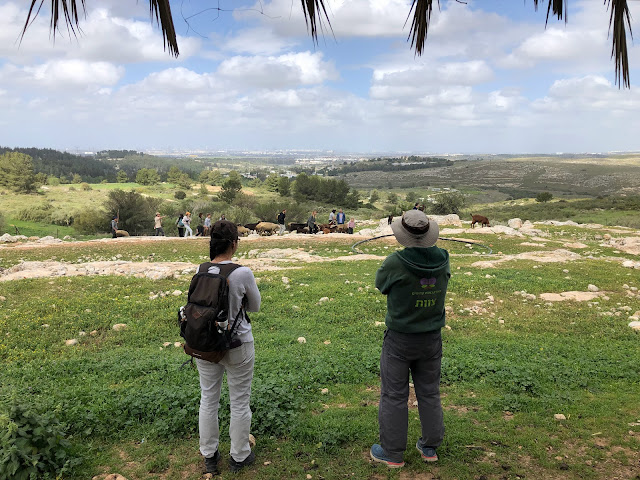Lessons through Nature
“The first group will herd all the sheep and goats into that
circle over there.” For a split second, I thought he was joking, but as our
guide, Yair stared at the group sitting on the other side of the bench, I realized
that he meant what he said. I was glad he didn’t choose our group first. I
wanted to see how this would turn out.
About ten other students started walking towards the grazing
animals, who seemed focused on nothing but eating the grass before them. There
were between twenty and forty sheep and goats wandering around the pen. After
some time, they finally pushed, lead, and even carried all the creatures into a
ring about ten feet in diameter. Then it was our turn and I realized why the
first group took so long. The sheep and goats were slow and liked to eat, but
surprisingly they would go where we wanted if we were persistent. We learned to
lead them from behind. If we led them from the front or raised our voices, they
would be spooked by our shadows and would turn away from us. Shepherds need to
be firm yet gentle leaders.
Neot Qedumim is a large biblical landscape reserve. In fact,
it is the only reserve of its kind in the world, preserving 625 acres of plants
and animals from the time of the Bible so visitors can experience for
themselves the nature that is so prevalent in the scriptures. Yair said this
place is a photo album of biblical times.
From the time of Adam, people have lived in this region by working the land. God’s blessings often involve a plentiful harvest and enough rain. Thus, one of the most important resources is water. But besides the Jordan River and the Sea of Galilee, there aren’t many natural, year-round water sources. The people were dependent on the rain. The rainy season is less than half the year and, in that time, rainfall varies from five to fifty-five days in a year based on the area. Every year, the people prayed for God’s provision of water. The Hebrew word for heaven, “Shamaim,” literally means “there, water.”
Ancient Israelites took advantage of the rain in several ways. One method was through digging cisterns. Underground cisterns are a foreign concept for most of the modern world, but for ancient cities and villages, they were as common as bus stops are today. A cistern is a large hole dug out of the rock and plastered on the inside to hold water. Some cisterns are so huge, they could host a wedding celebration inside. They were built in strategic locations so that when it rained, the water would run into them and fill them for the dry season. Hopefully, the water would last until the next rain.
Yair sat us down before a restored cistern so we could see the same sight as the Israelites. From our perspective, it was a low rock with
a square hole in the middle. He had one of the students raise some water up
with a bucket and pour it into a collecting pool outside the cistern. With each bucket load, the water level rose in the pool and eventually flowed back into the cistern. We heard the lively sound of splashing in the darkness below.
The scriptures are full of imagery about water, especially “living
waters.” Cisterns do not hold this living, flowing water. After a few weeks, it
begins to be stagnant and stale. The best water came from wells or even springs, providing water that is flowing and full of minerals.
We continued moving through the nature preserve. In the
distance, we heard the popping of guns from a practice range for the IDF
(Israel Defense forces). Much of this land has been held through constant
fighting. Even when the children of Israel came from Egypt it was only because
the Lord fought for them (Exodus 14:14). One of the most memorable stories from
the time of the Exodus was the first Passover (Pesach) which Jewish people
continue to celebrate each spring. One of God’s commands to the people before
they left Egypt was to mark their doorposts with blood, using a branch of
hyssop. Yair showed us the actual spice called hyssop or Za’atar in Arabic.
This plant is still used today to make a spice mix for food seasoning.
Another fascinating plant we saw was called the Jujube tree
(scientific name, Ziziphus Spinachristi). It was a short tree, the ones that we saw were between 5 and 15 feet tall. It had thin branches and sparse oval leaves. The branches were
lined with thorns, some of them sticking straight out and others curved
backward toward the base of each stem.
 |
| The sparce yet spiny branches of a Jujube tree |
As suggested by its scientific name, the Jujube tree is
probably most famous for being the supposed tree that Roman soldiers used to
make a crown of thorns for Jesus before his crucifixion. Apparently, these
thorns naturally protected the plant from animals like sheep who love to eat its tender shoots. If this plant was actually the one used for Jesus’ crown,
the Lamb of God was willingly pierced by thorns meant to ward off sheep.
The most valuable resource from an olive tree is its oil. As
we looked at one of the old trees, we also saw an olive crusher and press.
Harvesters put whole olives into a circular, stone container and drive a donkey
attached to a stone wheel that crushes them. They then take the mash and press
it to collect the golden juices. They don’t pit the olives because the pits
have a little oil in them and a preservative that keeps the oil from spoiling
for about a year. Before refrigeration existed, people used to preserve cheeses
and other perishables in oil.
 |
| An old olive tree, with an olive crusher and press to its left. |




Comments
Post a Comment